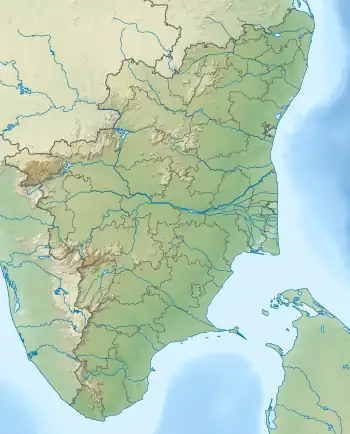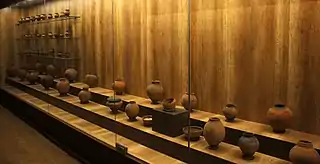 Shown within Tamil Nadu  Adichanallur (India) | |
| Alternative name | ஆதிச்சநல்லூர் |
|---|---|
| Location | Thoothukudi, India |
| Coordinates | 8°44′N 77°42′E / 8.73°N 77.7°E |
| Type | Settlement |
| History | |
| Founded | 905 BC–696 BC |
| Cultures | Ancient Tamils |
| Site notes | |
| Excavation dates | 1876–present |
Adichanallur is an archaeological site in Thoothukudi district in Tamil Nadu, India that has been the site of a number of very important archaeological finds. Korkai, the capital of the Early Pandyan Kingdom, is located about 15 km from Adichanallur. Carbon dating of samples excavated in 2004 from the Adichanallur site has revealed that they belonged to the period between 1000 BC and 600 BC.[1][2] In 2005, around 169 clay urns containing human skeletons were unearthed that date back to at-least 3,800 years.[3] In 2018, research on copper metal remains remains were dated at Manipur University to 1500 BC (+ or - 700 years). But dating was not accepted as accurate.[4][5]
Present Excavations
In 2004, a number of skeletons were found buried in earthenware urns. Some of these urns contained writing in Tamili (Tamil-Brahmi) script.
On March 18, 2019, the report of artifact samples sent to Beta Analytic Testing Laboratory, USA for carbon dating was obtained. The results were submitted to the Madurai Bench of the Madras High Court on April 4, 2019. Carbon dating of samples excavated from the Adichanallur site in Thoothukudi district has revealed that they belonged to the period between 905 BC to 696 BC. A Division Bench of Justices N. Kirubakaran and S. S. Sundar observed that this proved Adichanallur was one of the earliest ancient sites in Tamil Nadu. The court had expressed its displeasure that the artifacts, first excavated in 2004-06 under the supervision of the then Superintending Archaeologist T. Satyamurthy, were not sent for carbon dating for over 15 years. “In spite of many efforts taken by intellectuals, historians, political leaders and archaeologists, nothing was done by the ASI, for reasons best known to them, to send the Adichanallur samples for carbon dating,” the court said. The court had earlier directed the ASI to fence the whole site that is spread across 114 acres and put up a police outpost to prevent any damage. With Sathyabama Badrinath, former Regional Director (South), ASI, currently with the Delhi circle, nominated for preparing the report, the court said that the reports of T. Satyamurthy could also be added in achieving a comprehensive report[1]
Historical Excavations

Adichanallur first gained attention in the year 1876 when a team of three eminent people visited it. The team consisted of the then Collector of Tirunelvely district, district engineer and an Ethnologist from Germany called Dr. Jagor. The team started excavating in one side of a mound and discovered many earthen pots that were of superior quality than the ones being sold at the bazaars of the late 19th Century. Also found were baked earthenware utensils, a number of iron weapons and implements (mainly knives, short sword blades and hatchets) and a huge number of bones and skulls.
Alexander Rea, a former Superintendent from Southern Circle Archaeological Survey of India pointed out that all these artifacts were taken away by Dr. Jagor for the Berlin Museum für Völkerkunde, currently called as Ethnological Museum of Berlin. Alexander Rea himself had done a detailed investigation of the sites during the period between 1899 and 1905, when he was able to find a large number of artifacts similar to Dr. Jagor.
All the artifacts that Rea found was promptly cataloged and documented in his 1915 book titled "Catalog of the Prehistoric Antiquities from Adichanallur and Perambair". It is surprising to note that although the catalog consisted of huge amounts of bronze, iron, gold and earthen artifacts combined, the present day excavations yielded mainly earthen wares only. All of Rea's artifacts are supposedly present in India.
In-Situ Museum
On August 5, 2023, Union Minister for Finance Nirmala Sitharaman laid the foundation stone for a museum in Adichanallur. Upon completion, this will be one of the first on-site museums in India.[6]
See also
References
- 1 2 Chandar, B. Tilak (5 April 2019). "Adichanallur site belongs to a period between 905 and 696 BC". The Hindu. Retrieved 6 April 2019 – via www.thehindu.com.
- ↑ Chandar, B. Tilak (26 February 2019). "Samples sent for carbon dating: ASI". The Hindu. ISSN 0971-751X. Retrieved 20 September 2019.
- ↑ "Skeletons dating back 3,800 years throw light on evolution - Times of India". The Times of India. Retrieved 6 April 2019.
- ↑ Kalyanaraman, M. (12 January 2018). "The ghosts of Adichanallur: Artefacts that suggest an ancient Tamil civilisation of great sophistication". The Hindu. ISSN 0971-751X. Retrieved 20 September 2019.
- ↑ Subramanian, T. s (17 February 2005). "'Rudimentary Tamil-Brahmi script' unearthed at Adichanallur". The Hindu. ISSN 0971-751X. Retrieved 20 September 2019.
- ↑ "Union Finance Minister Nirmala Sitharaman lays foundation stone for Adichanallur museum that will exhibit 3,000-year-old artefacts". The Hindu. 5 August 2023. ISSN 0971-751X. Retrieved 5 August 2023.
Further reading
External links
- Archaeological Survey of India's Page on Adichanallur excavations
- Rudimentary Tamil-Brahmi script unearthed at Adichanallur[usurped] - The Hindu, 17 Feb 2005
- Iron Age habitational site found at Adichanallur - The Hindu, 3 Apr 2005
- Some pottery parallels - Spread of material culture from south to Deccan? - The Hindu, 25 May 2007
- Prehistoric antiquities in Tinnevelly
- Adichanallur: An Interesting Historical Site of Tamil Nadu
- News from Times of India - ASI had sent two samples to the Florida lab and the lab repo ..